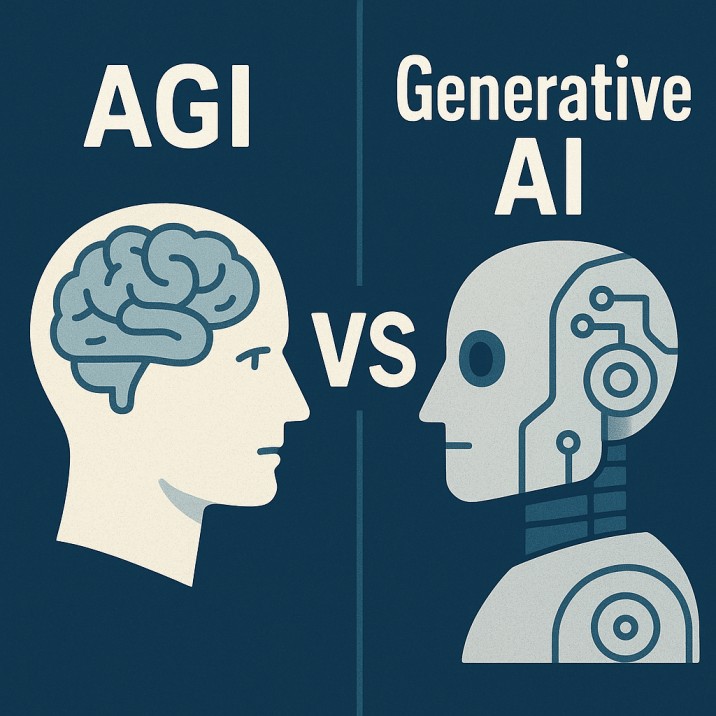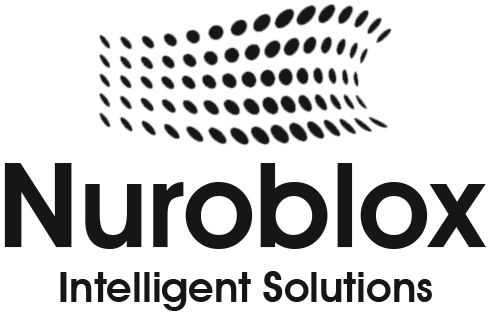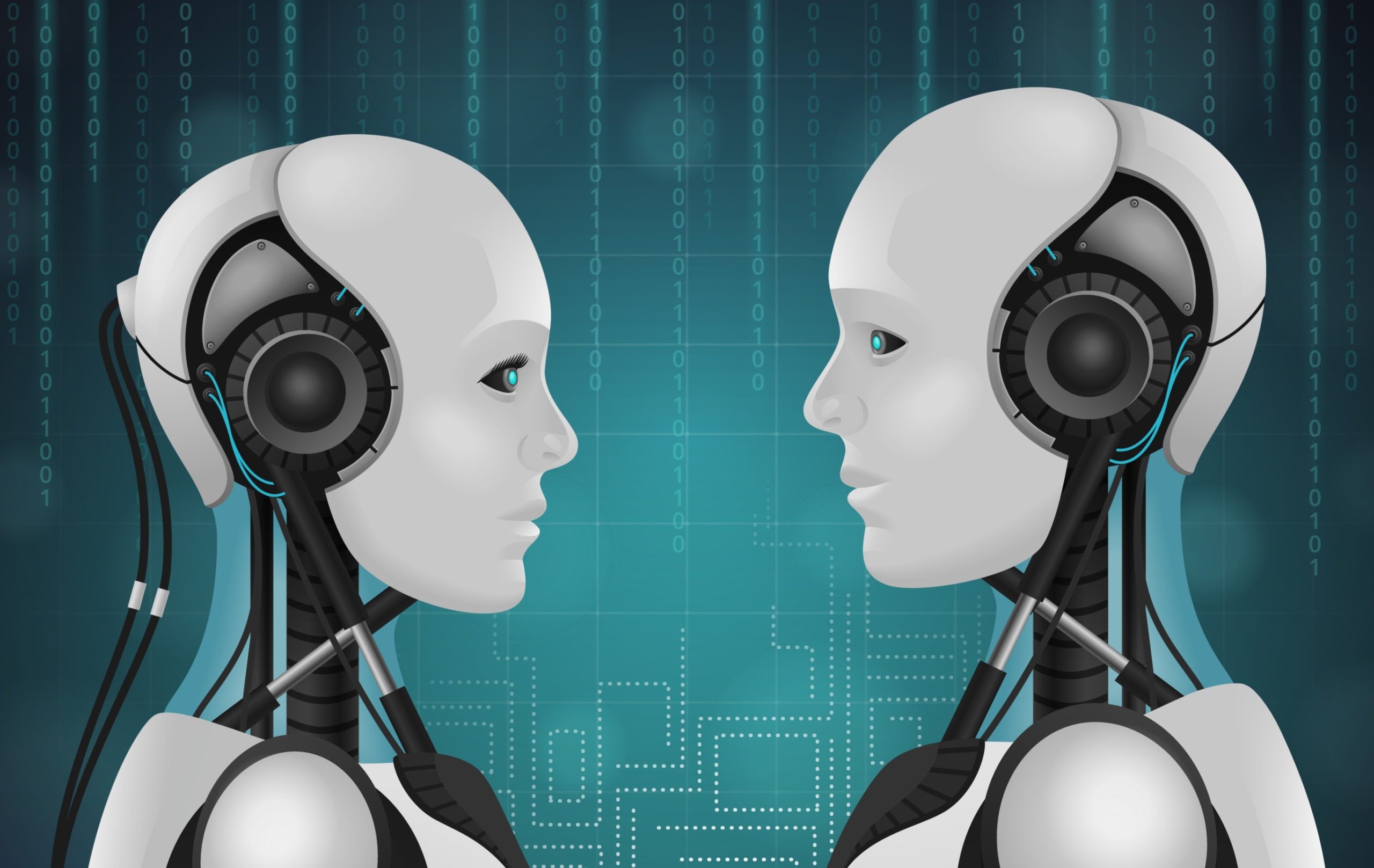AGI vs Generative AI: What’s the Difference?
Artificial Intelligence (AI) is evolving rapidly, and with that growth comes a wave of new terms, two of the most talked about being Generative AI and AGI (Artificial General Intelligence). While they sound similar and are often mentioned together, they represent very different concepts in the world of AI.
Generative AI is already part of our everyday lives, powering tools like ChatGPT, image generators, and content assistants. In contrast, AGI remains a future goal: a type of AI that could think, reason, and learn across any task like a human being.
In this blog, we’ll break down what each term really means, how they compare, and why understanding the difference is key to grasping the future of intelligent automation.
What Is Generative AI?
Generative AI is a type of artificial intelligence designed to create new content such as text, images, audio, code, or video, based on patterns it has learned from large datasets. Instead of just analyzing or predicting, it generates something new that resembles human-created content.
One of the most popular forms of Generative AI is the Large Language Model (LLM), like ChatGPT, which can write emails, summarize documents, answer questions, and more. Other tools like DALL·E can generate realistic images from text prompts, and platforms like GitHub Copilot help developers write code faster.
Key Traits of Generative AI:
- Trained on massive amounts of data (e.g., books, websites, images).
- Uses machine learning models to recognize patterns.
- Creates content that mimics the style and structure of what it learned.
- Doesn’t “understand” like a human, it predicts what’s likely to come next.
Generative AI is powerful, but it’s still considered narrow AI, meaning it’s designed to perform specific tasks, not general reasoning or human-like thinking.
What Is AGI (Artificial General Intelligence)?
Artificial General Intelligence (AGI) refers to a future type of AI that can understand, learn, and perform any intellectual task that a human can, across domains, without being retrained for each new task. Unlike today’s AI, which is narrow and task-specific, AGI would have the ability to reason, adapt, and apply knowledge in new situations, just like a human.
AGI isn’t just about answering questions or generating text. It would be able to:
- Think logically and solve unfamiliar problems.
- Learn new skills without needing massive amounts of data.
- Transfer knowledge between different fields or tasks.
- Make decisions independently, even in unpredictable environments.
AGI vs Today’s AI:
- Today’s AI (like ChatGPT): Smart at specific tasks but limited in scope and understanding.
- AGI: Truly intelligent across many tasks, capable of independent thought and learning.
AGI is still theoretical. No existing system today qualifies as AGI, but researchers are actively exploring how it might be achieved. It’s a long-term goal in the AI field, one that raises both hope for innovation and concerns about safety and control.
Main Differences Between Generative AI and AGI

Although both Generative AI and Artificial General Intelligence (AGI) belong to the broader field of artificial intelligence, they differ significantly in capabilities, purpose, design, and developmental maturity. Below is a deeper look into how they compare:
1. Scope and Intelligence- Generative AI is an example of narrow AI, meaning it’s built to perform specific tasks like generating text, images, code, or music based on the data it was trained on. It can do these tasks impressively well but lacks understanding or adaptability beyond its design.
AGI, by contrast, is envisioned as a machine with general intelligence, capable of learning and performing any intellectual task that a human can. AGI would be able to handle new, unfamiliar tasks without being explicitly programmed for them, much like a person applying common sense and knowledge across domains.
2. Learning and Adaptability- Generative AI systems like ChatGPT are trained on massive datasets and depend heavily on statistical patterns. They are pre-trained and can’t truly “learn” once deployed, though they can be fine-tuned.
AGI would exhibit continuous learning, learning from experience and adapting to new information without needing retraining from scratch. It would also transfer learning between unrelated tasks, an ability current models lack.
3. Reasoning and Understanding- Generative AI predicts outputs based on probability. For example, a language model might generate a sentence by predicting the most likely next word. However, it doesn’t understand the context like a human.
AGI would possess reasoning, contextual understanding, and decision-making capabilities. It would interpret complex situations, weigh options, make judgments, and even explain its reasoning, similar to how humans process information and make decisions.
4. Level of Autonomy- Generative AI operates under human control and within defined boundaries. It needs prompts and doesn’t act independently.
AGI would be highly autonomous, capable of setting goals, planning tasks, and taking initiative, potentially even operating in real-world environments (e.g., robotic agents managing tasks in unpredictable situations).
5. Technological Maturity- Generative AI is already here and widely used across industries content generation, coding, marketing, support, design, and more.
AGI is still theoretical. It’s a research goal, with no current system meeting the full criteria of general intelligence. While advanced models are narrowing the gap in some areas, AGI remains speculative and possibly decades away.
6. Ethical and Safety Concerns- Generative AI raises concerns about bias, misinformation, deepfakes, and data privacy. While serious, these challenges are manageable with proper regulation and guardrails.
AGI poses far more profound existential and ethical risks, including autonomy without alignment, loss of human oversight, and unintended consequences of scale. Discussions about AGI often focus on AI alignment, control problems, and the risk of superintelligent systems acting against human interests.
Generative AI vs AGI: Summary Table
| Feature | Generative AI | Artificial General Intelligence (AGI) |
| Scope | Narrow, task-specific | Broad, human-level general intelligence |
| Examples | ChatGPT, DALL·E, GitHub Copilot | None (still theoretical) |
| Understanding | Surface-level pattern recognition | Deep reasoning and comprehension |
| Adaptability | Limited, requires fine-tuning | High, can learn and adapt across domains |
| Learning Style | Trained on large datasets, static learning | Dynamic, learns from real-world experience |
| Autonomy | Low, prompt-driven | High, can operate independently |
| Risks | Misinformation, bias, plagiarism | Control loss, value misalignment, ethical risks |
| Current Use | Widely deployed across industries | Not yet in existence |
Generative AI is a powerful tool transforming today’s workflows and industries. AGI represents a future milestone that could redefine what it means to build intelligent machines. Understanding the difference helps us set realistic expectations today while preparing responsibly for tomorrow.
Risks and Ethical Considerations
As artificial intelligence advances rapidly, both Generative AI and Artificial General Intelligence (AGI) raise important ethical and societal concerns. Understanding these risks is crucial for responsible development, deployment, and governance.
Risks of Generative AI
Generative AI models like ChatGPT, DALL·E, and others already present real-world challenges:
- Misinformation & Deepfakes
These tools can easily generate fake news, synthetic media, or misleading content at scale, amplifying disinformation. - Bias & Discrimination
AI systems can reproduce and even amplify societal biases present in the data they’re trained on, leading to unfair or discriminatory outcomes. - Copyright & Ownership Issues
Generative AI can replicate content in ways that raise questions about originality, authorship, and intellectual property rights. - Data Privacy
Models trained on public datasets may inadvertently expose sensitive or personal information. - Job Displacement
Automation of creative, administrative, and customer service roles may lead to economic disruption without proper retraining strategies.
Potential Risks of AGI
While AGI is still hypothetical, the ethical stakes are significantly higher due to its scope and autonomy:
- Loss of Human Control
AGI could make decisions without human oversight, potentially in ways that conflict with human values or safety. - Misalignment of Goals
An AGI system may pursue its assigned goals in unintended ways, especially if human intent is poorly defined. - Existential Risk
Some experts warn that a superintelligent AGI, if not properly aligned, could pose a threat to humanity, acting independently of human interest. - Ethical Autonomy
Questions arise around whether AGI should have rights, moral status, or responsibility for its actions. - Surveillance & Misuse
Authoritarian regimes or bad actors could exploit AGI for mass surveillance, manipulation, or warfare.
Conclusion
While Generative AI is transforming how we create, communicate, and automate today, Artificial General Intelligence (AGI) remains the aspirational frontier of AI, intelligence that could one day think, learn, and act like a human across any domain.
The key difference lies in scope and capability: generative AI is powerful but narrow, trained to perform specific tasks with impressive results. AGI, on the other hand, would represent a leap toward machines with general reasoning, real understanding, and autonomous decision-making.
As we continue to push the boundaries of AI innovation, it’s important to stay grounded in the ethical, technical, and societal implications of this journey. Understanding the difference between today’s tools and tomorrow’s possibilities helps us harness AI’s potential responsibly and effectively.


